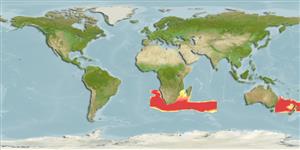>
Lophiiformes (Anglerfishes) >
Oneirodidae (Dreamers)
Etymology: Oneirodes: Greek, 'oneiros' = a dream or dreamlike or out of a dream (suggesting this fish is so strange and marvelous that can exist only in dreams) (Ref. 86949).
Environment: milieu / climate zone / depth range / distribution range
Ecologia
marinhas batipelágico; intervalo de profundidade 0 - 2000 m (Ref. 10977), usually ? - 1000 m (Ref. 86949). Deep-water; 18°S - 45°S, 0°E - 180°E (Ref. 86949)
Circumglobal, southern latitudes of SE Atlantic, Indian and Western Pacific ocean; northernmost record off Port Hedland, Western Australia , at about 18°S; southernmost record on the Pacific side of the South I. of New Zealand, about 45°S.
Tamanho / Peso / Idade
Maturity: Lm ? range ? - ? cm
Max length : 11.1 cm SL macho/indeterminado; (Ref. 58502); common length : 2.0 cm TL macho/indeterminado; (Ref. 10977); common length :7.5 cm TL (female)
Descrição suscinta
Morfologia | Morfometria
Espinhos dorsais (total): 1; Raios dorsais (total): 5-6; Espinhos anais 0; Raios anais : 4. Characterized by having escal morphology: pair of highly branched medial escal appendages, in combination with an elongate cylindrical lateral escal appendage on each side; well-developed lateral escal appendage; esca with a pair of stout, medial appendages; more globose form, having a deeper and longer head and a longer lower jaw than O.anisacanthus; short subopercle, dorsal end rounded or tapering to a point, without indentation on posterodorsal margin; length of ventral fork of opercle 28.6-31.9% SL; ratio of lengths of dorsal and ventral forks of opercle 0.47-0.53; absence of epibranchial teeth; presence of teeth on pharyngobranchial II; upper jaw teeth 16-55; lower jaw teeth 24-50; teeth on vomer 4-8; dorsal fin rays 5-6; anal fin rays 4; pectoral fin rays 16-18; head length 38.6-64.3% SL; head depth 43.9-50.5% SL; length of premaxilla 30.7-35.5% SL; length of lower jaw 45.5-52.3% SL; illicial length 22.3-27.3% SL (Ref. 86949).
Mesopelagic species (Ref. 7300, 75154). Most specimens taken in depths less than 1000 m with bottom trawls (Ref. 86949). Maximum depth reported in Ref. 10977. No male specimens are known.
Ciclo de vida ou comportamento de acasalamento
Maturidade | Reprodução | Desova | Ovos | Fecundidade | Larvas
Pietsch, T.W., 1986. Oneirodidae. p. 375. In M.M. Smith and P.C. Heemstra (eds.) Smith's sea fishes. Springer-Verlag, Berlin. (Ref. 10977)
Status na Lista Vermelha da UICN (Ref. 130435)
Ameaça para os humanos
Harmless
Uso pelos humanos
Pescarias: sem interesse
Mais informação
Nomes comunsSinônimosMetabolismoPredadoresEcotoxicologiaReproduçãoMaturidadeDesovaAgregação de desovaFecundidadeOvosDesenvolvimento dos ovos
Idade/TamanhoCrescimentoPeso-comprimentoComprimento-comprimentoFrequências de comprimentoMorfometriaMorfologiaLarvasDinâmica larvalRecrutamentoAbundânciaBRUVS
ReferênciasAquaculturaPerfil para aquaculturaEstirpesGenéticaElectrophoresesHereditariedadeDoençasProcessamentoNutrientsConversão de massa
ColaboradoresFotosStamps, Coins Misc.SonsCiguateraVelocidadeTipo de nataçãoÁrea branquialOtólitosCérebrosVisão
Ferramentas
Relatórios especiais
Baixar XML
Fontes da internet
Estimates based on models
Preferred temperature (Ref.
123201): 5.2 - 12.9, mean 7.9 °C (based on 145 cells).
Índice de diversidade filogenética (Ref.
82804): PD
50 = 0.5000 [Uniqueness, from 0.5 = low to 2.0 = high].
Bayesian length-weight: a=0.01995 (0.00906 - 0.04395), b=3.01 (2.83 - 3.19), in cm total length, based on all LWR estimates for this body shape (Ref.
93245).
Nível Trófico (Ref.
69278): 4.0 ±0.7 se; based on size and trophs of closest relatives
Resiliência (Ref.
120179): médio(a), tempo mínimo de duplicação da população 1,4 - 4,4 anos (Preliminary K or Fecundity.).
Fishing Vulnerability (Ref.
59153): Low vulnerability (10 of 100).
